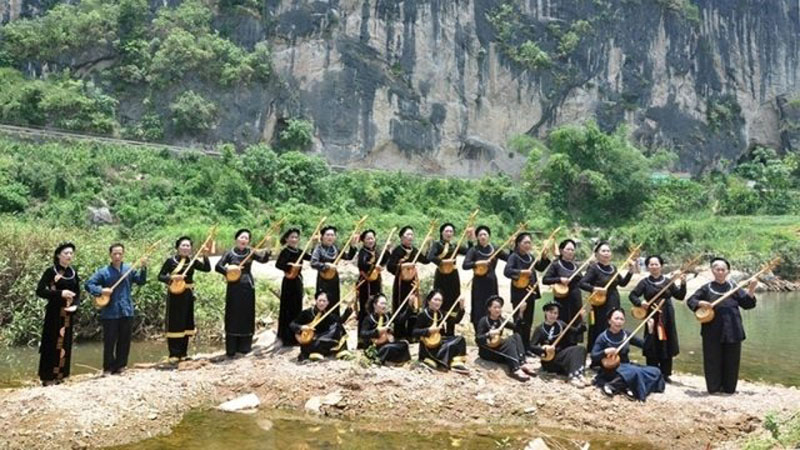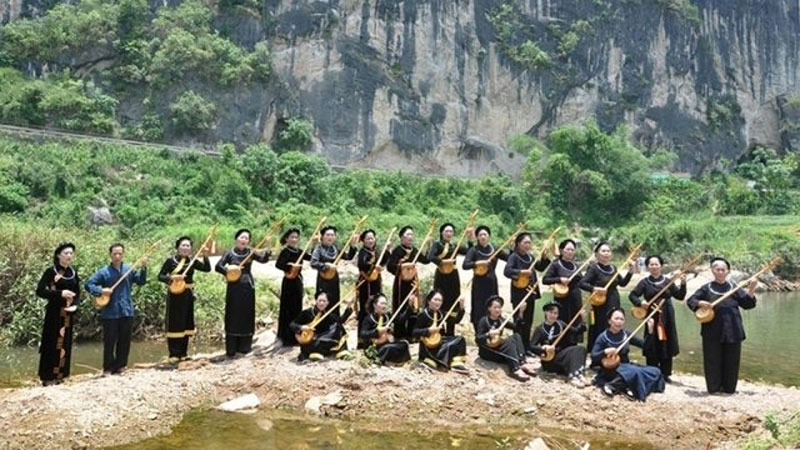


Every year when the spring comes, a Then Singing Festival is staged in Ngoc Tri hamlet, To Hieu commune, Binh Gia district, under the host of 97-year-old Meritorious Artist Mo Thi Kit.
Born in Ngoc Tri hamlet, the cradle of Then singing of Tay and Nung ethnic groups in Lang Son province, Kit has been immersed in the beautiful melodies of Then singing since she was a young girl and has inherited the singing techniques from Then masters.
After becoming a daughter-in-law of the Nong family, which has nine successive generations of practicing Then, Kit was taught by her mother-in-law on ancient Then tunes, which are sung on special occasions, including peace praying, longevity worshipping, new-house celebrations, and rituals to dispel bad luck.
Throughout her nearly 70 years of maintaining a strong attachment to Then, Kit has shared her experience to numerous Then lovers inside and outside Lang Son province and has won much appreciation and respect from fellow villagers.
Despite her old age, she still hosts Then fests at home on every spring to commemorate ancestors and bring villagers closer. The events provide a venue for the young and old to meet and enjoy charming Then songs accompanied by Tinh gourd lutes.
According to Kit, the lyrics of Then songs are valuable experience of the ancestors in production and daily life. She revealed that she can sing by heart tens of thousands of Then lines. When she was younger, Kit took part in a number of Then singing competitions in Lang Son province and in the northern regions, during which she won many prizes.

A performance by members of the Then Singing Club in Nam Sam town, Van Lang district, Lang Son province.
Kit’s love for Then was handed down to her daughter, Nong Thi Phuong, who is head of Binh Gia district’s association for preserving folk singing. Phuong said that she fell into Then since she was a little girl listening to sweet Then melodies from her mother, maternal and paternal grandmothers.
Another respected Then master in Lang Son is Meritorious Artist Mong Thi Sam, 80, from Po Tang hamlet, Hop Thanh commune, Cao Loc district. With nearly 64 years following her career as a Then practitioner, Sam said that it is hard work which requires not only passion but also restrictive practice. A Then master not only has to learn Then songs by heart but also thoroughly grasp every rite-of-passage of a specific Then ritual.
Also born in Binh Gia district, Meritorious Artist Trieu Thuy Tien soon fell in love with the Then folk art of Tay and Nung ethnic groups. Retired as a member of the Lang Son provincial art troupe 16 years ago, Tien is now busy with teaching Then at singing clubs inside and outside Lang Son province.
Thuy Tien is now head of the provincial Folk Singing Club, which was established in 2009 under the decision of Lang Son provincial Centre for Culture and Information. Starting from only 12 members, the club is now home to more than 300 people of different ages between 16 and 76, who come from different ethnic groups of Tay, Nung, Dao, and Kinh across the province.
The successful operation of the club has facilitated the launch of 10 district-level clubs, which have attracted thousands of people who have a common passion for Then singing in residential areas.
Every month, Tien opens a training course to enhance the musical playing and singing techniques in villages, wards and towns in the province, during which many talented amateur Then singers and musical instrumentalists have been discovered.
Thanks to the effort made by devoted veteran Then masters and practitioners, the practice of Then singing has been promoted among the public, particularly the youth, in Lang Son province.
However, according to musician Hoang Huy Am, Vice Chairman of Lang Son provincial Association for Preservation of Folk Music Preservation, the involvement of and support from functional sectors, proper investment and sound solutions are also needed to safeguard and uphold the treasured value of the folklore art form in the community.